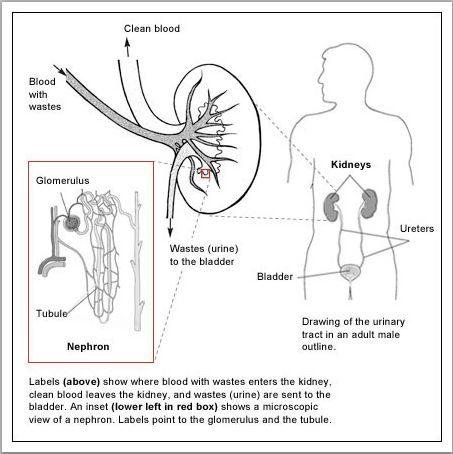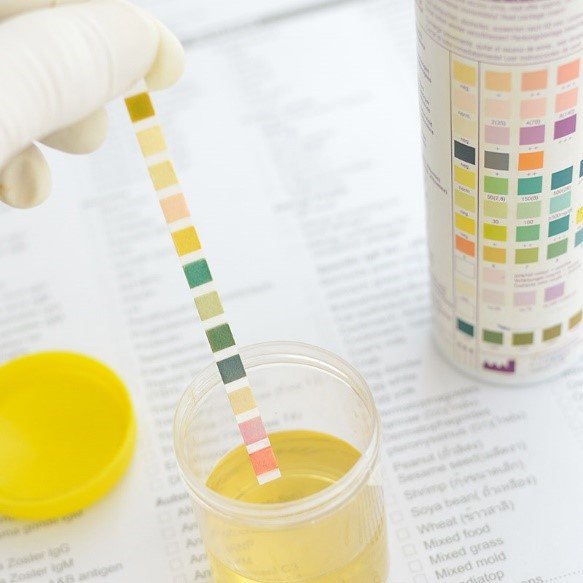Also Known As :
Urine Test, Urine Analysis, UA
Formal Name :
Urinalysis
Why Get Tested :
To screen for, help diagnose and/or monitor several diseases and conditions, such
as kidney disorders or urinary tract infections (UTIs)
When to Get Tested :
When the patient has symptoms, such as fever, fever with chills, abdominal pain,
back pain, frequent or painful urination; sometimes as part of a health
examination, pregnancy check-up, hospital admission, or pre-surgical work-up.
Sample Required :
One to two ounces of urine—a sufficient sample is required for accurate results;
sometimes you may be directed to collect a sample using a "clean-catch" technique: women
should spread the labia of the vagina and clean from front to back; men should wipe the
tip of the penis. Start to urinate, let some urine fall into the toilet, then collect
one to two ounces of urine in the container provided, then void the rest into the
toilet.
Test Preparation Needed :
None
What is being tested?
A urinalysis is a group of physical, chemical, and microscopic tests. The tests detect
and/or measure several substances in the urine, such as by-products of normal and
abnormal metabolism, cells, cellular fragments, and bacteria.
Overview
Urine is produced by the kidneys, two fist-sized organs located on either side of the
spine at the bottom of the ribcage. The kidneys filter wastes out of the blood, help
regulate the amount of water in the body, and conserve proteins, electrolytes, and other
compounds that the body can reuse. Anything that is not needed is eliminated in the
urine, traveling from the kidneys through ureters to the bladder and then through the
urethra and out of the body. Urine is generally yellow and relatively clear, but each
time a person urinates, the colour, quantity, concentration, and content of the urine
will be slightly different because of varying constituents.

Many disorders may be detected in their early stages by identifying substances that are
not normally present in the urine and/or by measuring abnormal levels of certain
substances. Some examples include glucose, protein, bilirubin, red blood cells, white
blood cells, crystals, and bacteria. They may be present because:
- There is an elevated level of the substance in the blood and the body responds by
trying to eliminate the excess in the urine.
- Kidney disease is present.
- There is a urinary tract infection present, as in the case of bacteria and white
blood cells.
Consists of:
A complete urinalysis consists of three distinct testing phases:
-
Visual examination, which evaluates the urine's colour and clarity
-
Chemical examination, which tests chemically for about 9 substances that provide
valuable information about health and disease and determines the concentration
of the urine.
-
Microscopic examination, which identifies and counts the type of cells, casts,
crystals, and other components such as bacteria and mucus that can be present in
urine.
A microscopic examination is typically performed when there is an abnormal finding on
the visual or chemical examination, or if a healthcare practitioner specifically orders
it.
Abnormal findings on a urinalysis may prompt repeat testing to see if the
results are still abnormal and/or may be followed by additional urine and blood tests to
help establish a diagnosis.
Ever wonder what happens to your blood sample once it's been collected? It's sent "to the
lab" for analysis, but what does that entail? This article will take you on a tour as a
blood sample is processed.
In the laboratory, trained laboratorians use various
methods to analyze your sample as determined by what types of tests you need performed.
The Who's Who in the Lab article introduces you to these lab personnel.
For every
test, there is an appropriate sample that provides the best information for that test.
Test Process
How is the sample collected for testing?
One to two ounces of urine is collected in a clean container. A sufficient sample is
required for accurate results.
Urine for a urinalysis can be collected at any time.
In some cases, a first morning sample may be requested because it is more concentrated
and more likely to detect abnormalities.
Sometimes, you may be asked to collect a
"clean-catch" urine sample. For this, it is important to clean the genital area before
collecting the urine. Bacteria and cells from the surrounding skin can contaminate the
sample and interfere with the interpretation of test results. With women, menstrual
blood and vaginal secretions can also be a source of contamination. Women should spread
the labia of the vagina and clean from front to back; men should wipe the tip of the
penis. Start to urinate, let some urine fall into the toilet, then collect one to two
ounces of urine in the container provided, then void the rest into the toilet.
A
urine sample will only be useful for a urinalysis if taken to the healthcare provider's
office or laboratory for processing within a short period of time. If it will be longer
than an hour between collection and transport time, then the urine should be
refrigerated or a preservative may be added.
How are the test results used?
The urinalysis is a set of screening tests that can detect some common diseases. It may
be used to screen for and/or help diagnose conditions such as a urinary tract infection,
kidney disorders, liver problems, diabetes or other metabolic conditions, to name a
few.
A urinalysis is comprised of several chemical, microscopic and visual
examinations used to detect cells, cell fragments and substances such as crystals or
casts in the urine associated with the various conditions listed above. It can detect
abnormalities that might require follow-up investigation and additional testing. Often,
substances such as protein or glucose will begin to appear in the urine before people
are aware that they may have a problem.
In people diagnosed with diseases or
conditions, such as kidney disease or diabetes, the urinalysis may be used in
conjunction with other tests, such as urine albumin, to follow treatment.
There are
many factors that can affect or interfere with the tests that comprise a urinalysis. If
instructed to do so, it is important to follow the directions carefully for a
"clean-catch" sample. Give a complete history to your healthcare practitioner, including
any prescribed or over-the-counter medications or supplements you may be taking. If you
are a woman, be sure to tell your healthcare practitioner whether you are menstruating.
Is the time of day a factor when collecting a urine sample?
Because this is a general screening test, time of collection is usually not important,
although a first morning void may be preferred because it is more concentrated. However,
if your healthcare provider is looking for a specific finding, you may be asked to
collect a sample at a specific time.








